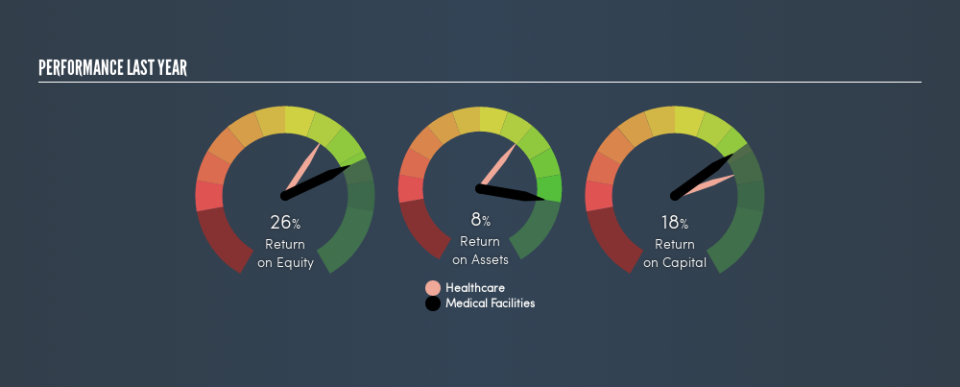Here’s What Medical Facilities Corporation’s (TSE:DR) ROCE Can Tell Us

Want to participate in a short research study? Help shape the future of investing tools and receive a $20 prize!
Today we’ll evaluate Medical Facilities Corporation (TSE:DR) to determine whether it could have potential as an investment idea. To be precise, we’ll consider its Return On Capital Employed (ROCE), as that will inform our view of the quality of the business.
First up, we’ll look at what ROCE is and how we calculate it. Next, we’ll compare it to others in its industry. Finally, we’ll look at how its current liabilities affect its ROCE.
What is Return On Capital Employed (ROCE)?
ROCE is a metric for evaluating how much pre-tax income (in percentage terms) a company earns on the capital invested in its business. In general, businesses with a higher ROCE are usually better quality. Overall, it is a valuable metric that has its flaws. Renowned investment researcher Michael Mauboussin has suggested that a high ROCE can indicate that ‘one dollar invested in the company generates value of more than one dollar’.
How Do You Calculate Return On Capital Employed?
The formula for calculating the return on capital employed is:
Return on Capital Employed = Earnings Before Interest and Tax (EBIT) ÷ (Total Assets – Current Liabilities)
Or for Medical Facilities:
0.18 = US$69m ÷ (US$470m – US$69m) (Based on the trailing twelve months to September 2018.)
So, Medical Facilities has an ROCE of 18%.
Check out our latest analysis for Medical Facilities
Does Medical Facilities Have A Good ROCE?
When making comparisons between similar businesses, investors may find ROCE useful. Medical Facilities’s ROCE appears to be substantially greater than the 10% average in the Healthcare industry. I think that’s good to see, since it implies the company is better than other companies at making the most of its capital. Independently of how Medical Facilities compares to its industry, its ROCE in absolute terms appears decent, and the company may be worthy of closer investigation.
When considering ROCE, bear in mind that it reflects the past and does not necessarily predict the future. ROCE can be deceptive for cyclical businesses, as returns can look incredible in boom times, and terribly low in downturns. ROCE is, after all, simply a snap shot of a single year. What happens in the future is pretty important for investors, so we have prepared a free report on analyst forecasts for Medical Facilities.
What Are Current Liabilities, And How Do They Affect Medical Facilities’s ROCE?
Liabilities, such as supplier bills and bank overdrafts, are referred to as current liabilities if they need to be paid within 12 months. The ROCE equation subtracts current liabilities from capital employed, so a company with a lot of current liabilities appears to have less capital employed, and a higher ROCE than otherwise. To counter this, investors can check if a company has high current liabilities relative to total assets.
Medical Facilities has total liabilities of US$69m and total assets of US$470m. Therefore its current liabilities are equivalent to approximately 15% of its total assets. A fairly low level of current liabilities is not influencing the ROCE too much.
The Bottom Line On Medical Facilities’s ROCE
Overall, Medical Facilities has a decent ROCE and could be worthy of further research. Of course, you might find a fantastic investment by looking at a few good candidates. So take a peek at this free list of companies with modest (or no) debt, trading on a P/E below 20.
I will like Medical Facilities better if I see some big insider buys. While we wait, check out this free list of growing companies with considerable, recent, insider buying.
We aim to bring you long-term focused research analysis driven by fundamental data. Note that our analysis may not factor in the latest price-sensitive company announcements or qualitative material.
If you spot an error that warrants correction, please contact the editor at editorial-team@simplywallst.com. This article by Simply Wall St is general in nature. It does not constitute a recommendation to buy or sell any stock, and does not take account of your objectives, or your financial situation. Simply Wall St has no position in the stocks mentioned. Thank you for reading.


